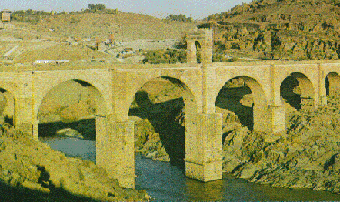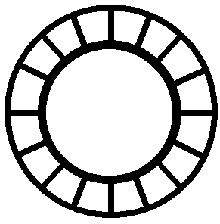 Contents -
Previous Article -
Next Article
Contents -
Previous Article -
Next Article
Roman Bridges and Bridge Building
The beautiful Roman bridge over the river Tagus at Alcanara in Spain has always been a favorite of the author's. The word "Alcantara" means bridge in the language of the Arabs who later conquered much of Spain in the Eighth Century. The bottoms of the arches are 140 feet above the low water mark and the entire structure is 200 feet tall. This bridge is such a magnificent example of the civil engineer's art that its builder, Caius Julius Lacer, had his tomb erected nearby. Perhaps he could see into the future as well as he could build bridges, for the inscription on his tomb reads:
"Pontem perpetui mansuram in saecula mundi - I leave a bridge forever in the centuries of the world"
The Romans gained much of their engineering skill from the Etruscans. From them, the Romans learned the use of the keystone arch, which enabled them to build extremely strong and durable bridges.
The challenge in building a bridge is to create a structure strong enough to span large distances while being able to bear heavy loads and not fall down of its own weight. A small footbridge across a stream could be built of wooden logs or a flat piece of stone. When a flat piece of stone is used to bridge or span a space between two upright supports, the method is called post and lintel construction. The problem with post and lintel is that a heavy weight on the middle of the span will put too much stress on the stone and will break it if the weight is heavy enough.
 The Romans solved this problem by using a type of construction called voussoir arch with keystone. The idea behind this technical sounding term is quite simple. Imagine a ring of tapered stone blocks arranged like the diagram at the right. If one were to take a rope, wrap it around the ring, and tighten it, all it would do is force the stones more tightly together. Exchange the rope for a steel cable and tighten by twisting with a steel bar shoved between the cable and the ring and the circle of stones just becomes stronger! If a really hefty steel cable were used or the whole assembly were pounded with heavy hammers, it might fracture and pulverize, but a mighty force indeed would have to be used to destroy a ring made with this type of construction.
The Romans solved this problem by using a type of construction called voussoir arch with keystone. The idea behind this technical sounding term is quite simple. Imagine a ring of tapered stone blocks arranged like the diagram at the right. If one were to take a rope, wrap it around the ring, and tighten it, all it would do is force the stones more tightly together. Exchange the rope for a steel cable and tighten by twisting with a steel bar shoved between the cable and the ring and the circle of stones just becomes stronger! If a really hefty steel cable were used or the whole assembly were pounded with heavy hammers, it might fracture and pulverize, but a mighty force indeed would have to be used to destroy a ring made with this type of construction.
 To create a voussoir arch, one half of this ring of stones was simply stood up on its ends. These ends rested on piers made of stone blocks mortared together with pozzolana cement in the typical Roman arch bridge. The weight of the stone and concrete of the bridge itself compressed the tapered stones together, making the arch an extremely strong structure. Heavy wagons and legions of troops could safely cross a bridge constructed of arches without collapsing the structure. Many of these bridges lasted long after the Roman Empire in the West had fallen and survived the period of barbarian destruction of the Fifth through Ninth Centuries. Several of the original stout Roman arch bridges lasted through the midle ages and on into modern times, even serving General George Patton in the fighting during World War II just as they had served Caesar and Trajan almost two millennia before.
To create a voussoir arch, one half of this ring of stones was simply stood up on its ends. These ends rested on piers made of stone blocks mortared together with pozzolana cement in the typical Roman arch bridge. The weight of the stone and concrete of the bridge itself compressed the tapered stones together, making the arch an extremely strong structure. Heavy wagons and legions of troops could safely cross a bridge constructed of arches without collapsing the structure. Many of these bridges lasted long after the Roman Empire in the West had fallen and survived the period of barbarian destruction of the Fifth through Ninth Centuries. Several of the original stout Roman arch bridges lasted through the midle ages and on into modern times, even serving General George Patton in the fighting during World War II just as they had served Caesar and Trajan almost two millennia before.
Go to next article:
Go back to previous article:
Return to Roman Engineers Table of Contents
 The Romans solved this problem by using a type of construction called voussoir arch with keystone. The idea behind this technical sounding term is quite simple. Imagine a ring of tapered stone blocks arranged like the diagram at the right. If one were to take a rope, wrap it around the ring, and tighten it, all it would do is force the stones more tightly together. Exchange the rope for a steel cable and tighten by twisting with a steel bar shoved between the cable and the ring and the circle of stones just becomes stronger! If a really hefty steel cable were used or the whole assembly were pounded with heavy hammers, it might fracture and pulverize, but a mighty force indeed would have to be used to destroy a ring made with this type of construction.
The Romans solved this problem by using a type of construction called voussoir arch with keystone. The idea behind this technical sounding term is quite simple. Imagine a ring of tapered stone blocks arranged like the diagram at the right. If one were to take a rope, wrap it around the ring, and tighten it, all it would do is force the stones more tightly together. Exchange the rope for a steel cable and tighten by twisting with a steel bar shoved between the cable and the ring and the circle of stones just becomes stronger! If a really hefty steel cable were used or the whole assembly were pounded with heavy hammers, it might fracture and pulverize, but a mighty force indeed would have to be used to destroy a ring made with this type of construction.
 Contents -
Previous Article -
Next Article
Contents -
Previous Article -
Next Article
 To create a voussoir arch, one half of this ring of stones was simply stood up on its ends. These ends rested on piers made of stone blocks mortared together with pozzolana cement in the
To create a voussoir arch, one half of this ring of stones was simply stood up on its ends. These ends rested on piers made of stone blocks mortared together with pozzolana cement in the